Are you dreaming of exploring Turkey’s rich history, vibrant culture, and stunning landscapes? With SIXT.VN, planning your dream vacation has never been easier. We offer personalized travel guidance, seamless airport transfers, handpicked hotel options, unforgettable tours and activities, and flexible flight booking. Get ready for a seamless journey! Consider this your go-to resource for planning a memorable Turkish adventure.
1. Unveiling Turkey: Essential Knowledge for Your Journey
1.1. Optimal Trip Length in Turkey: How Many Days are Ideal?
A minimum of 10 days in Turkey is recommended, although an action-packed 2-week itinerary is ideal. This gives you enough time to explore the main attractions and truly experience the country’s beauty and culture.
However, if your schedule only allows for a week in Turkey, focusing on two or three destinations from this guide will still offer a fulfilling experience. According to research from the Turkish Ministry of Culture and Tourism, in 2023, tourists who spent more than 10 days in Turkey had a 40% higher satisfaction rate than those who stayed less than a week.
A three-week Turkey itinerary could include additional locations or more time in Istanbul to delve deeper into its history and cultural diversity. Another option for a three-week trip is to spend it exploring the stunning coastline, hiking the famous Lycian Way through mountains, pine forests, and charming Turkish coastal villages. Turkey’s endless options cater to every traveler’s interests.
1.2. Prime Time to Visit Turkey: When Should You Plan Your Trip?
The summer months, from May to September, provide the best conditions for visiting Turkey with long, sunny, and hot days with minimal rainfall. If you don’t prefer the heat, April and October are also ideal times to visit.
Visiting Turkey in the winter offers the possibility of experiencing Cappadocia transformed into a winter wonderland.
If you plan on sailing along the Turquoise Coast or visiting other coastal areas, visiting during the summer is highly recommended. Many restaurants and hotels usually do not open until early May, similar to many European beach destinations.
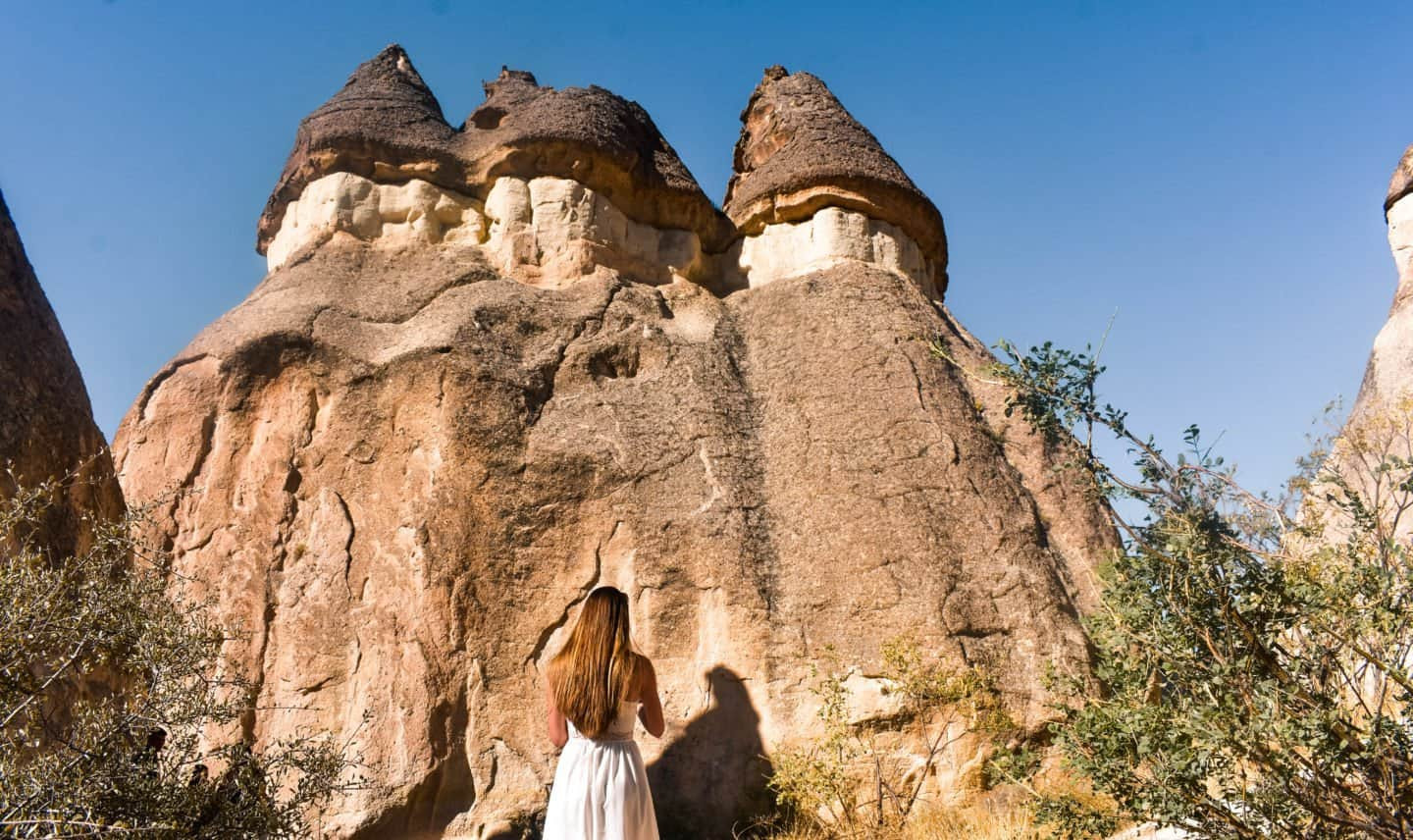 Cappadocia's fairy chimneys under a clear sky
Cappadocia's fairy chimneys under a clear sky
1.3. Navigating Turkey: What’s the Best Way to Get Around?
Turkey has a well-developed public transportation system, making it easy to travel around the country. Buses, trains, “dolmuş” (minibus services), and domestic airlines provide efficient and convenient options for exploring.
Most public transportation runs on time, is affordable, can be booked at the last minute, and is clean and comfortable. Enjoy the freedom of independent travel using Turkey’s public transportation.
1.4. Packing Essentials for Turkey: What Should You Bring?
What to bring to Turkey depends on the time of year. For summer visits, bring good walking shoes for sightseeing and exploration. Also, bring a sunhat, sunscreen, and sunglasses to protect yourself from the sun.
Because Turkey is mainly Muslim, it is important to dress conservatively in certain places, especially religious buildings in Istanbul. However, the country is generally relaxed and not too strict regarding attire.
1.5. Safety in Turkey: Is It Safe to Travel There?
Turkey is generally safe for tourists. Most governments advise against travel near the Syrian border.
Fortunately, the major tourist attractions in Turkey, like those in this travel guide, are far from the border.
Throughout the country, the Turkish people are friendly and hospitable. As with any major city in Europe, exercise caution in Istanbul. According to the Global Peace Index, in 2023, Turkey’s safety rating improved by 0.05 points compared to the previous year, reflecting increased stability and security for travelers.
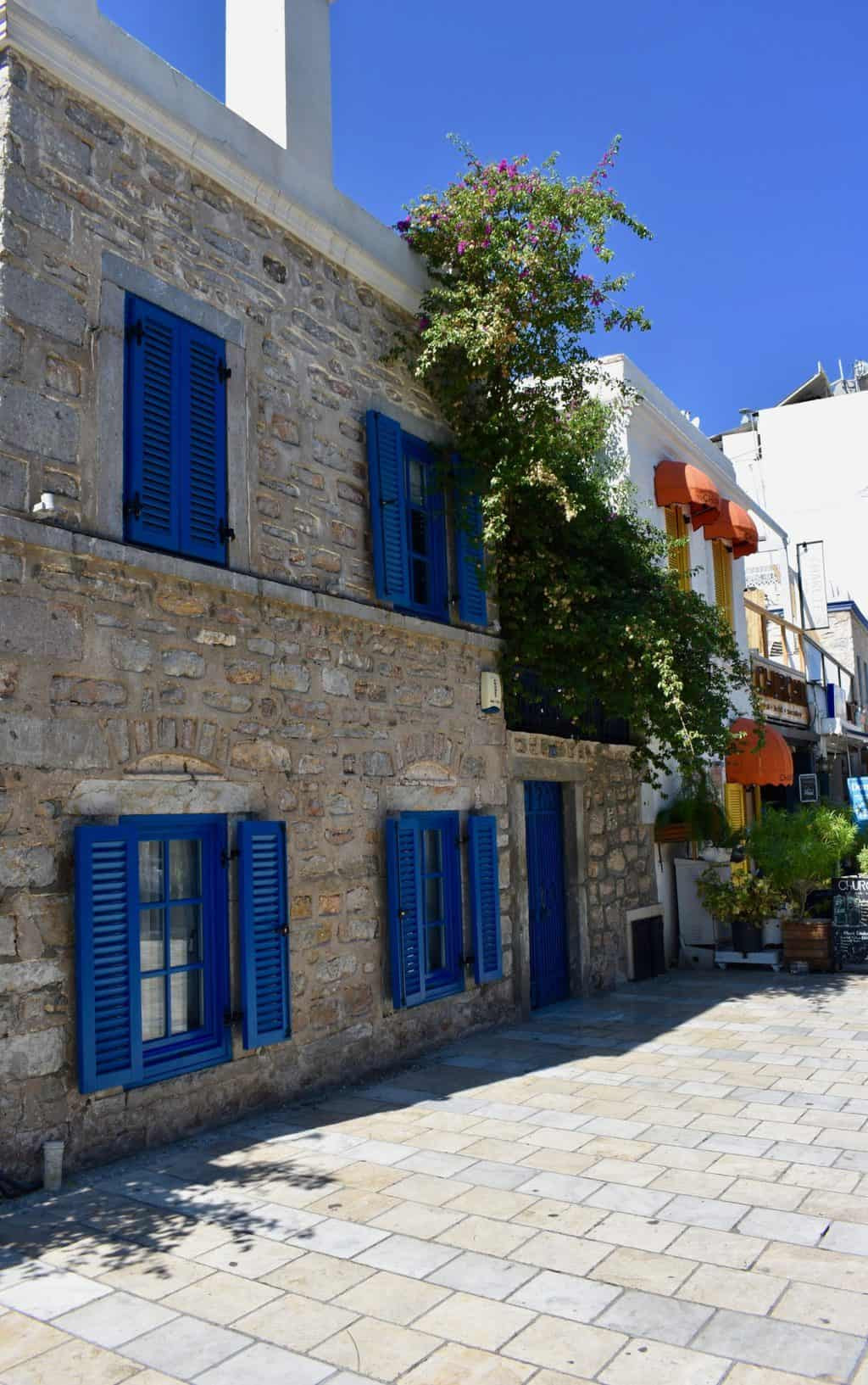 Charming street in Bodrum, Turkey
Charming street in Bodrum, Turkey
2. Planning Your 2-Week Turkey Itinerary: Essential Tips
Turkey is a well-known summer tourist destination. Its coastal towns have large airports, so you don’t necessarily have to start your trip in Istanbul.
You can fly into Bodrum, Izmir, Antalya, or Dalaman Airports, which are all located on the coast. This means that you can start your Turkey itinerary without having to go to Istanbul first.
Turkey is one of the best countries for independent travel. It has a comprehensive, affordable, and convenient public transportation system. No matter where you start your trip in Turkey, you’ll easily travel to your next destination.
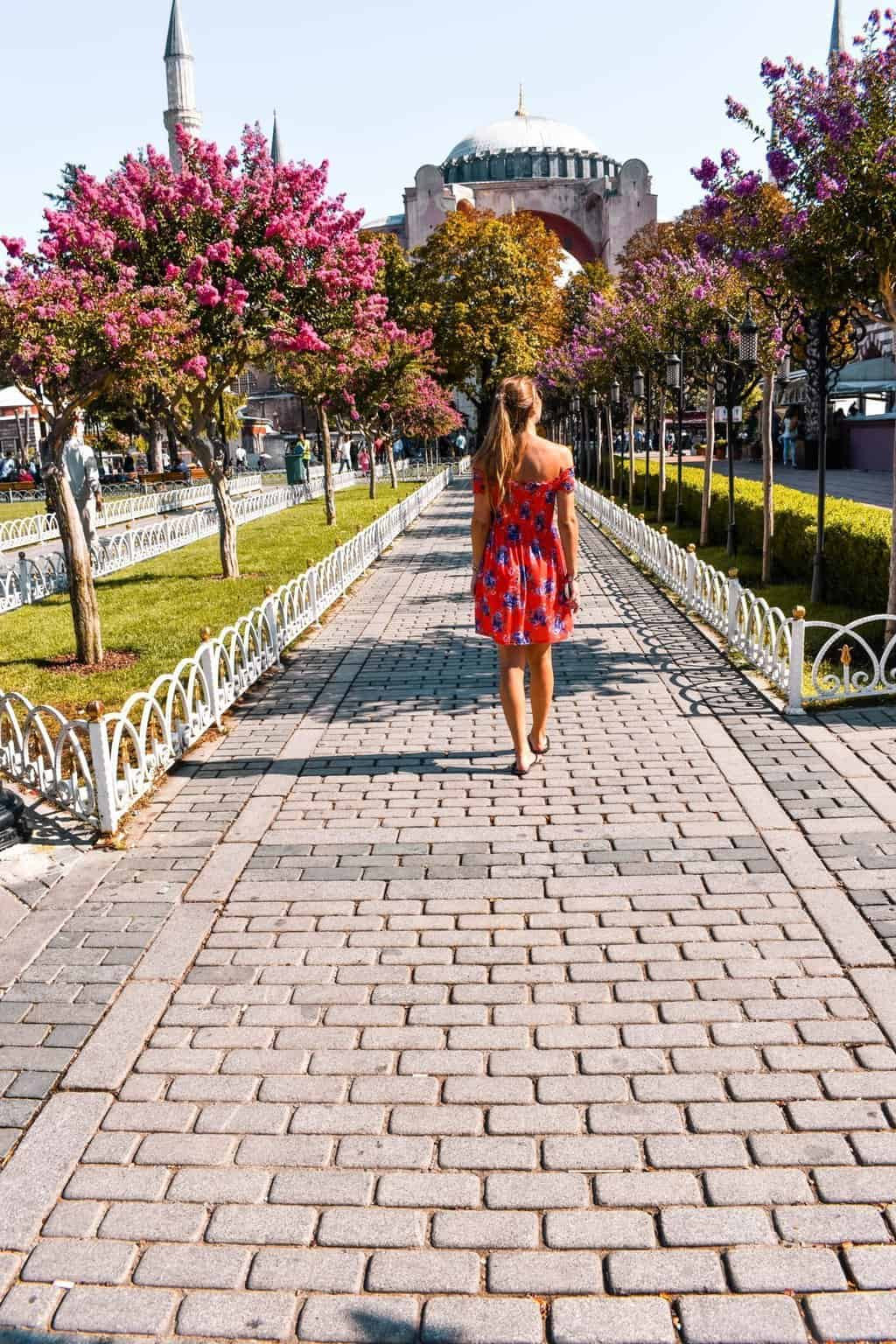 Istanbul in bloom
Istanbul in bloom
2.1. Travel Tips for Turkey: Maximizing Your Experience
- Check visa/entry requirements to enter Turkey. Visa costs depend on nationality. You can apply for your visa on the Turkish government’s e-visa website. SIXT.VN can assist you with this process to make your trip easier.
- Currency. The Turkish Lira (TL) is the currency. ATMs are available. Credit cards are widely accepted in hotels, restaurants, and shops in major cities and tourist areas. However, smaller establishments or local markets may prefer cash.
- Language. Turkish is Istanbul’s main language. Most people, especially those in hospitality, speak English, so communication shouldn’t be a problem.
- Bargaining. Bargaining is common in markets and some shops. Negotiate prices respectfully to get the best deals.
- Dress Code. While Turkey is generally modern, dressing modestly is recommended when visiting religious sites. Women should cover their heads, shoulders, and knees when entering mosques.
- Public Transportation. Utilize Turkey’s extensive bus and train network for affordable travel between cities. Consider purchasing a transportation card in larger cities for easy access to local transportation.
- Turkish Hospitality. Embrace Turkish hospitality by accepting offers of tea or coffee. These are common gestures of friendliness.
- Tipping. Tipping is customary in restaurants, cafes, and for services like taxis and hairdressers. A 10-15% tip is generally appreciated for good service.
- Local Customs. Respect local customs and traditions. Avoid public displays of affection and be mindful of noise levels, especially in residential areas.
- Emergency Numbers. Familiarize yourself with emergency numbers: Police (155), Ambulance (112), and Fire Department (110).
2.2. Museum Pass: Is It Worth It?
The Museum Pass is a great deal if you plan to visit multiple attractions, especially the destinations in this two-week Turkey itinerary. It covers your entry to many attractions and archaeological sites across Turkey, including Ephesus, Pamukkale, and Istanbul. You can buy it online or at the attractions that offer it.
3. A Detailed 2-Week Turkey Itinerary: Suggested Route
3.1. Bodrum: Coastal Charm
I flew from London to Bodrum in late August because it was the most affordable flight. It turned out to be a great first stop.
I wanted to visit Ephesus, and because public transportation was easy to get there, I decided Bodrum would be a great place to start my Turkey itinerary.
Bodrum was charming, lively, interesting, and beautiful. The town center does not have the large all-inclusive resort hotels that I had expected. The big resort hotels are located just outside of town, leaving the center of Bodrum as a delightful car-free zone. Spend one or two days in Bodrum, or spend a week soaking up the sun and enjoying the beaches.
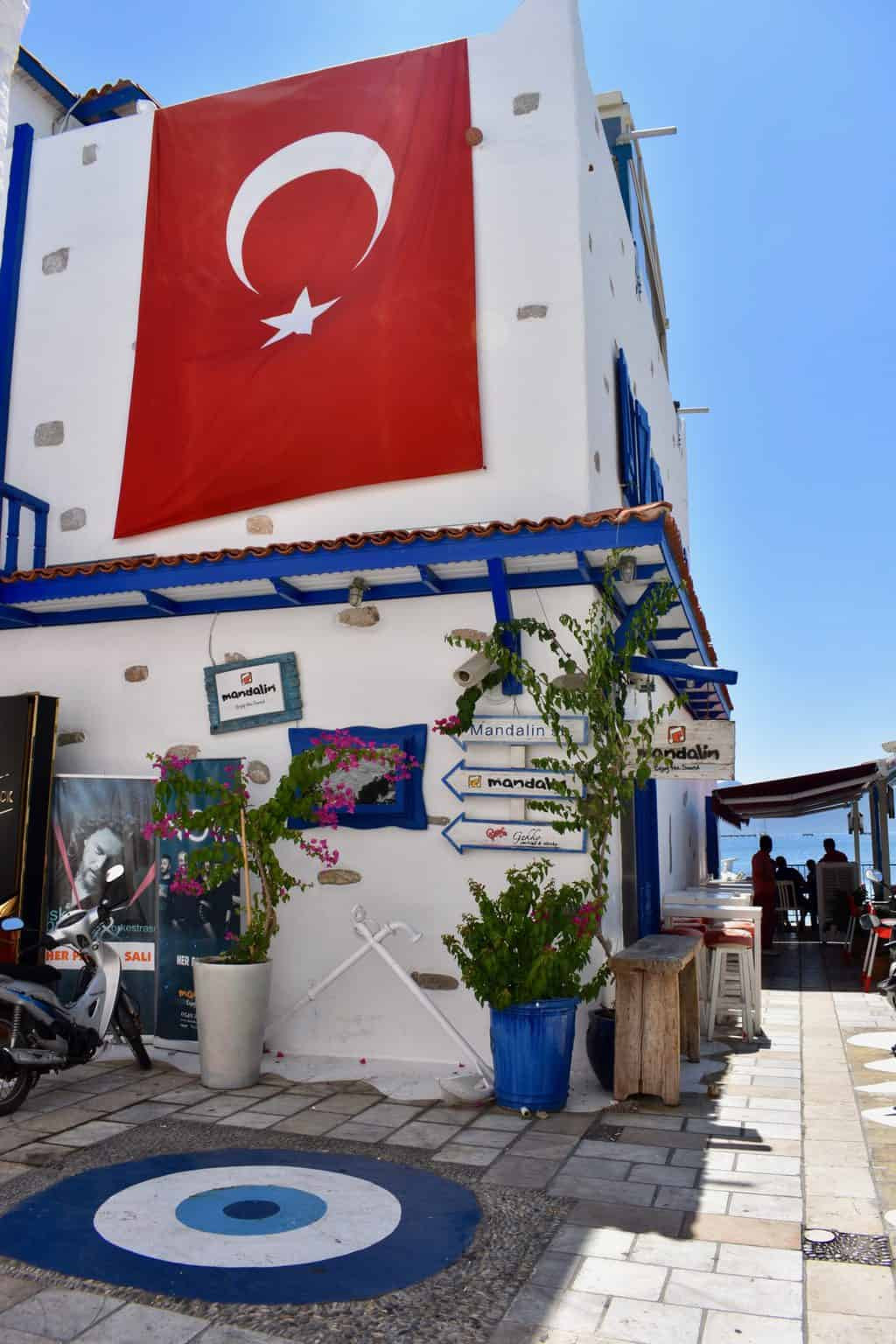 Bodrum, Turkey under a sunny sky
Bodrum, Turkey under a sunny sky
3.1.1. Where to Stay in Bodrum: Accommodation Options
There are plenty of budget and luxury hotels in Bodrum. A few suggestions for budget hotels in Bodrum:
- Eskici Hotel: Great hotel.
- Su Hotel: Pleasant stay.
- Costa Bodrum City: Provides the comforts of home.
Luxury hotels in Bodrum:
- Kempinski Hotel Barbaros Bay Bodrum: Offers luxury and comfort.
- The Bodrum EDITION: Great hotel, provides excellent service.
- Lujo Hotel Bodrum: Modern amenities and luxury accommodations.
3.1.2. Bodrum’s Best Activities: What to See and Do
From wandering its charming streets and visiting the historic Bodrum Castle to sampling the best of Turkish cuisine in the atmospheric restaurants, there are plenty of attractions to see and things to do in Bodrum.
If you are only visiting for a short time, book a local tour.
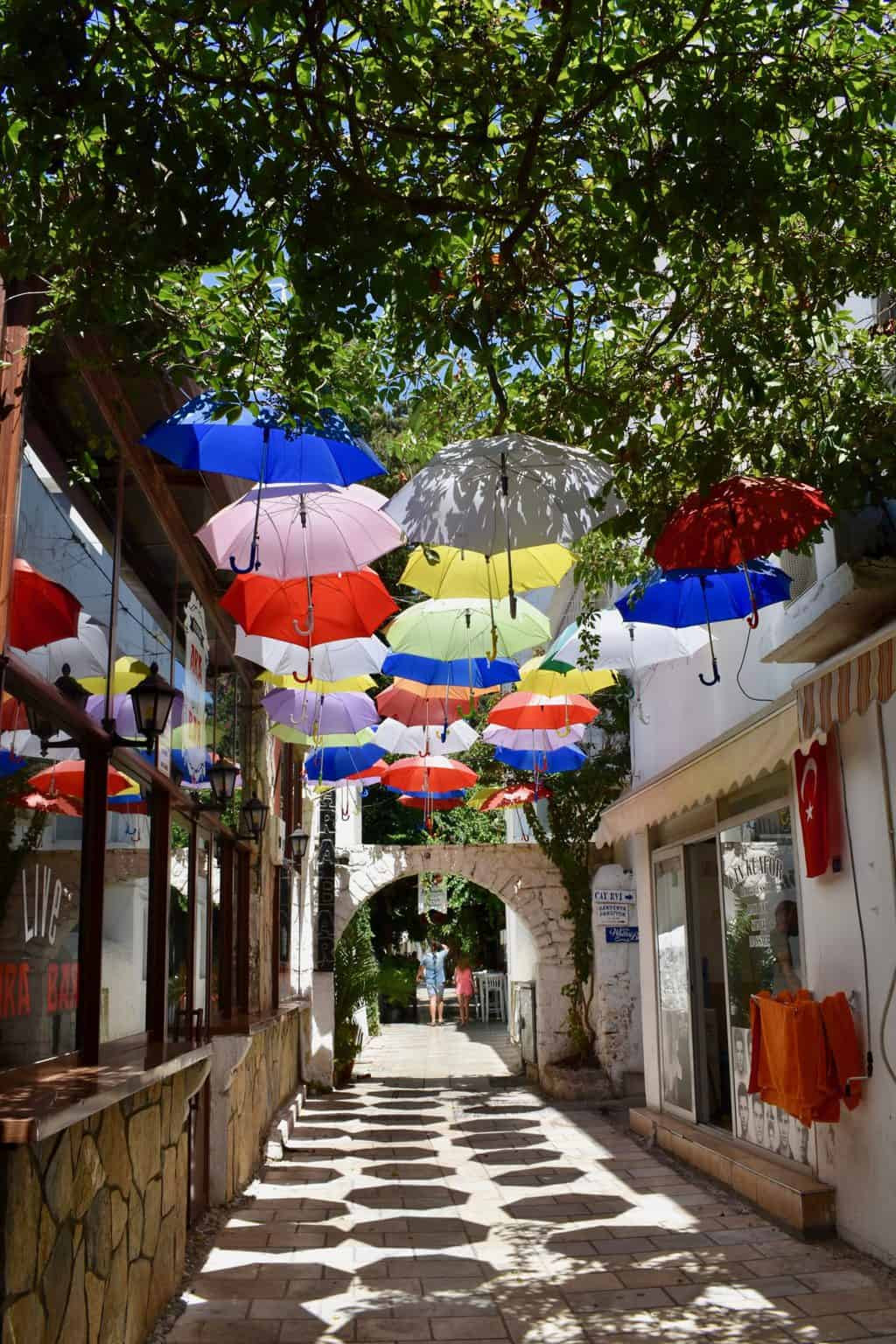 Exploring the laneways of Bodrum
Exploring the laneways of Bodrum
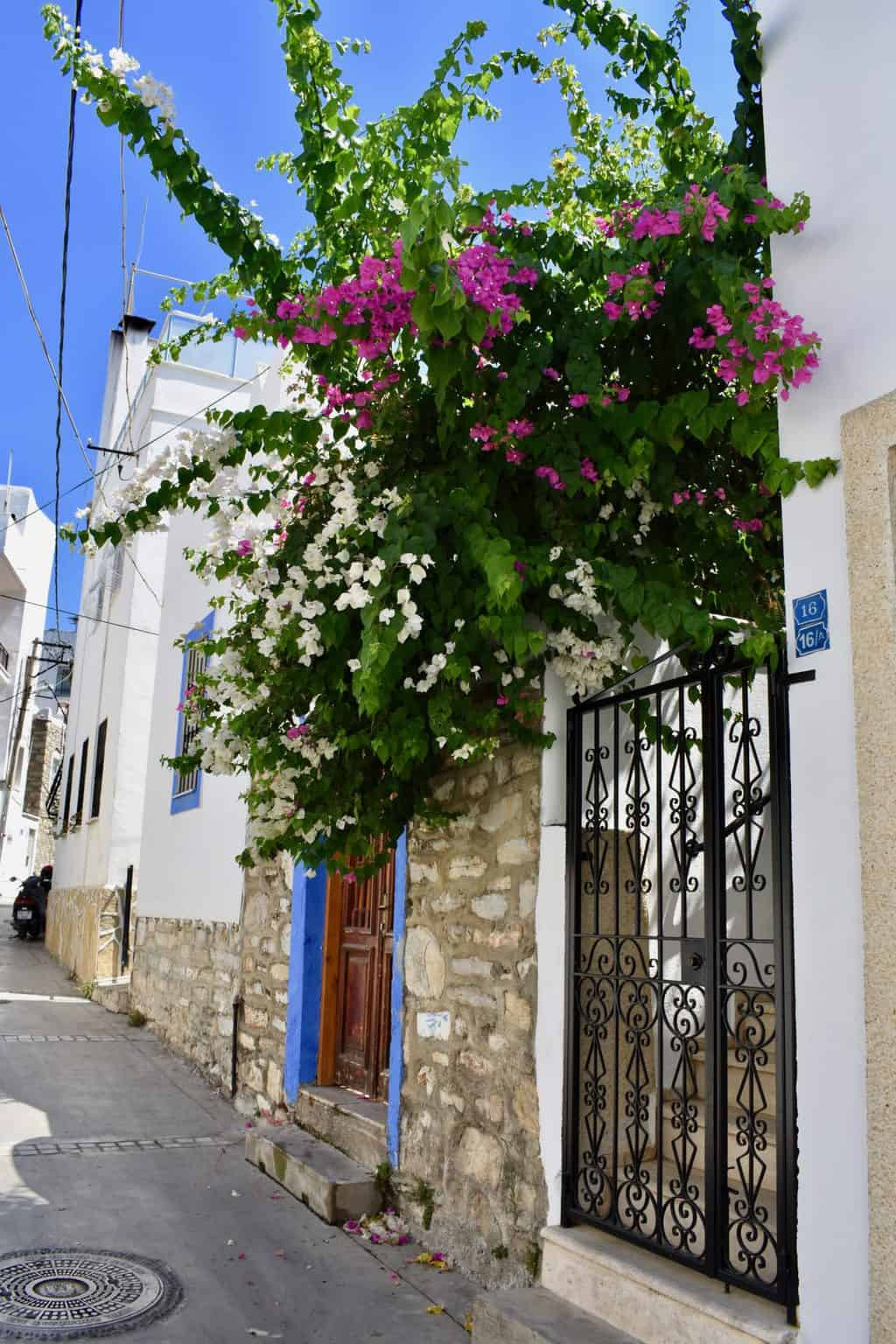 Exploring Bodrum's streets
Exploring Bodrum's streets
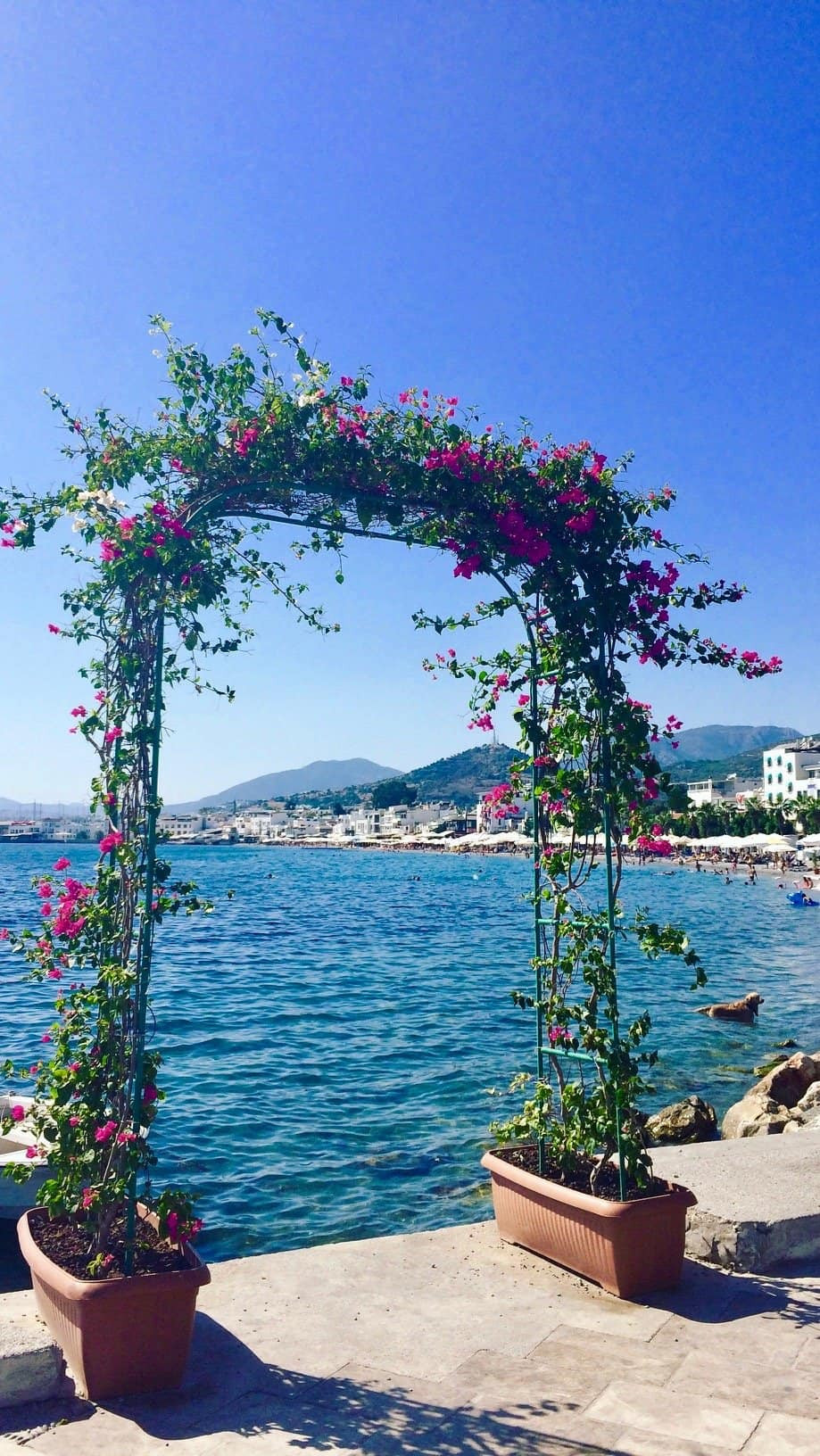 Bodrum's waterfront
Bodrum's waterfront
3.2. Ephesus and Selçuk: Ancient Wonders
Next stop: Ephesus and Selçuk. Travel time: 2h30 by public bus direct from Bodrum.
The ancient ruins of Ephesus are one of the top things to do in Turkey. Located near Izmir and the cruise port of Kusadasi, the ruins are popular with cruise day-trippers. Crowds arrive at Ephesus every day.
I visited Ephesus and Selçuk after Bodrum because it was a straight forward bus from between the two. I spent a full day exploring Ephesus, before spending the night in Selçuk.
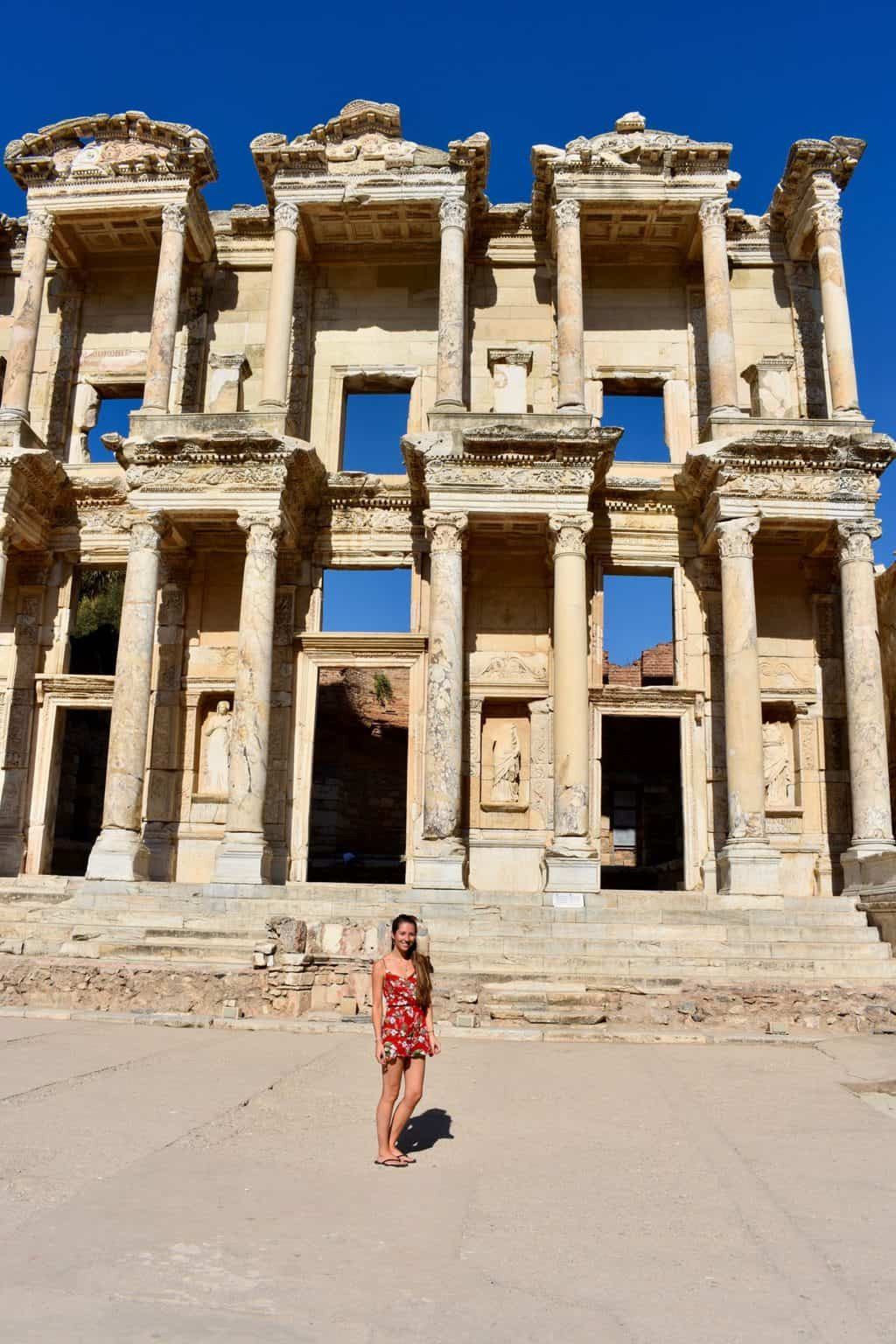 Library of Celsus in Ephesus
Library of Celsus in Ephesus
3.2.1. Ephesus Accommodation: Where to Stay
Selçuk is the nearest town to Ephesus. There are several mid-range hotels to choose from. I stayed at the Saint John Hotel, which was about a five-minute walk to the train station and offered a pleasant stay.
The lovely hotel is family-owned and run, and they made me feel right at home.
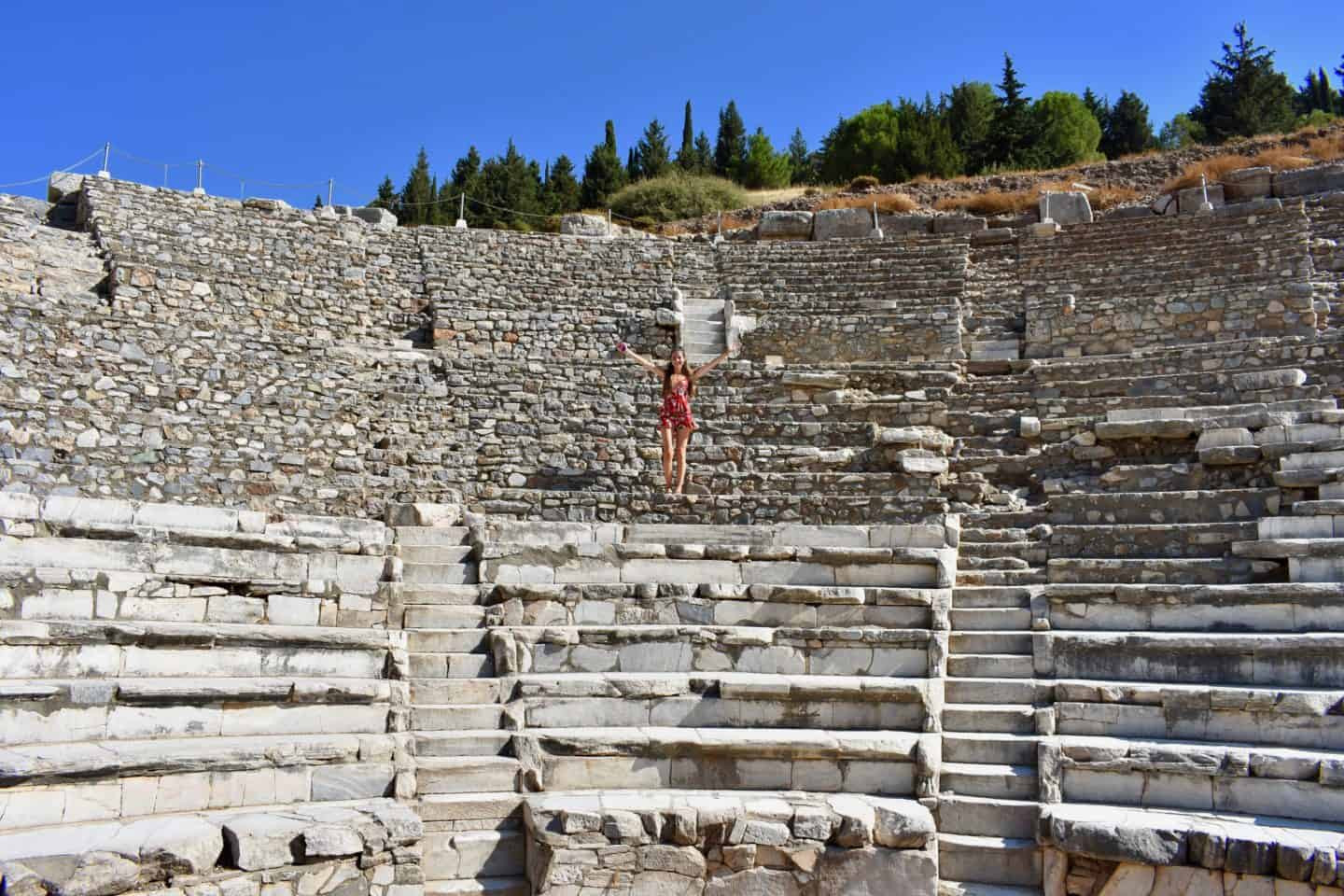 The Amphitheatre at Ephesus
The Amphitheatre at Ephesus
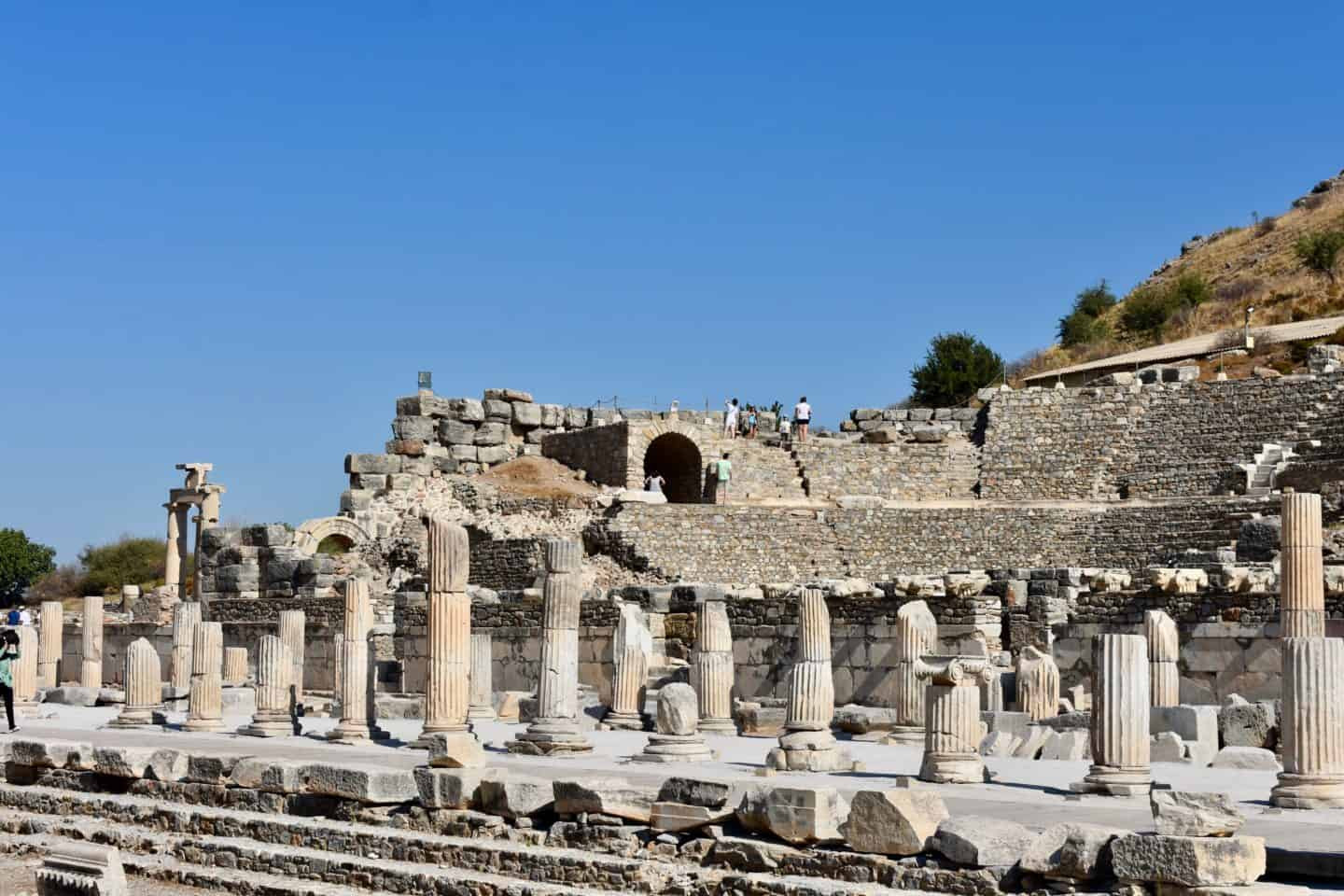 Ephesus ruins
Ephesus ruins
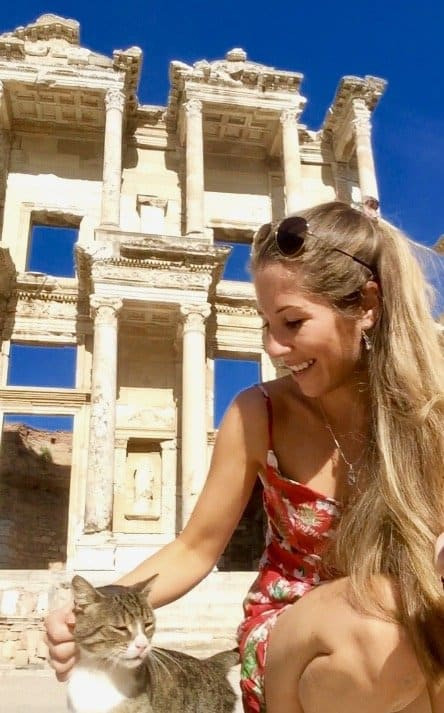 Ephesus cats
Ephesus cats
3.2.2. Ephesus Exploration: What to See
The main archeological sites include the Library of Celsus, the Temple of Artemis, and the amphitheatres. At the entrance, pick up a map, and there is signage throughout, so you could give yourself a self-guided tour through Ephesus. You can also arrange a tour through a local tour company in town, or book on a tour with GetYourGuide advance.
3.3. Pamukkale: The Cotton Castle
Next stop: Pamukkale. Travel time from Selçuk to Denizli: 3hr30 by direct train.
This spectacular natural wonder is unusual and distinctly different from anything else in Turkey. I’d highly recommend including a visit to Pamukkale on any Turkey itinerary. You can submerge yourself in these pools and explore Hierapolis at the top. Here are some fantastic ancient ruins, which are perhaps even more spectacular than Ephesus and definitely more overlooked.
We took the train from Selçuk to Denizli, which was just over 3 hours. From Denizli, we took the local bus to Pamukkale, which was straightforward.
However, a day trip to Pamukkale requires pre-planning. Arriving before the day-tripper crowds arrive makes for a much better experience, and you can enjoy an hour or more of the pools.
Visiting Pamukkale can be done as a day trip from nearby Denizli. You see many tours offering this.
I recommend spending the night before in Pamukkale for a less hurried experience.
One full day and one night is enough time to explore Pamukkale.
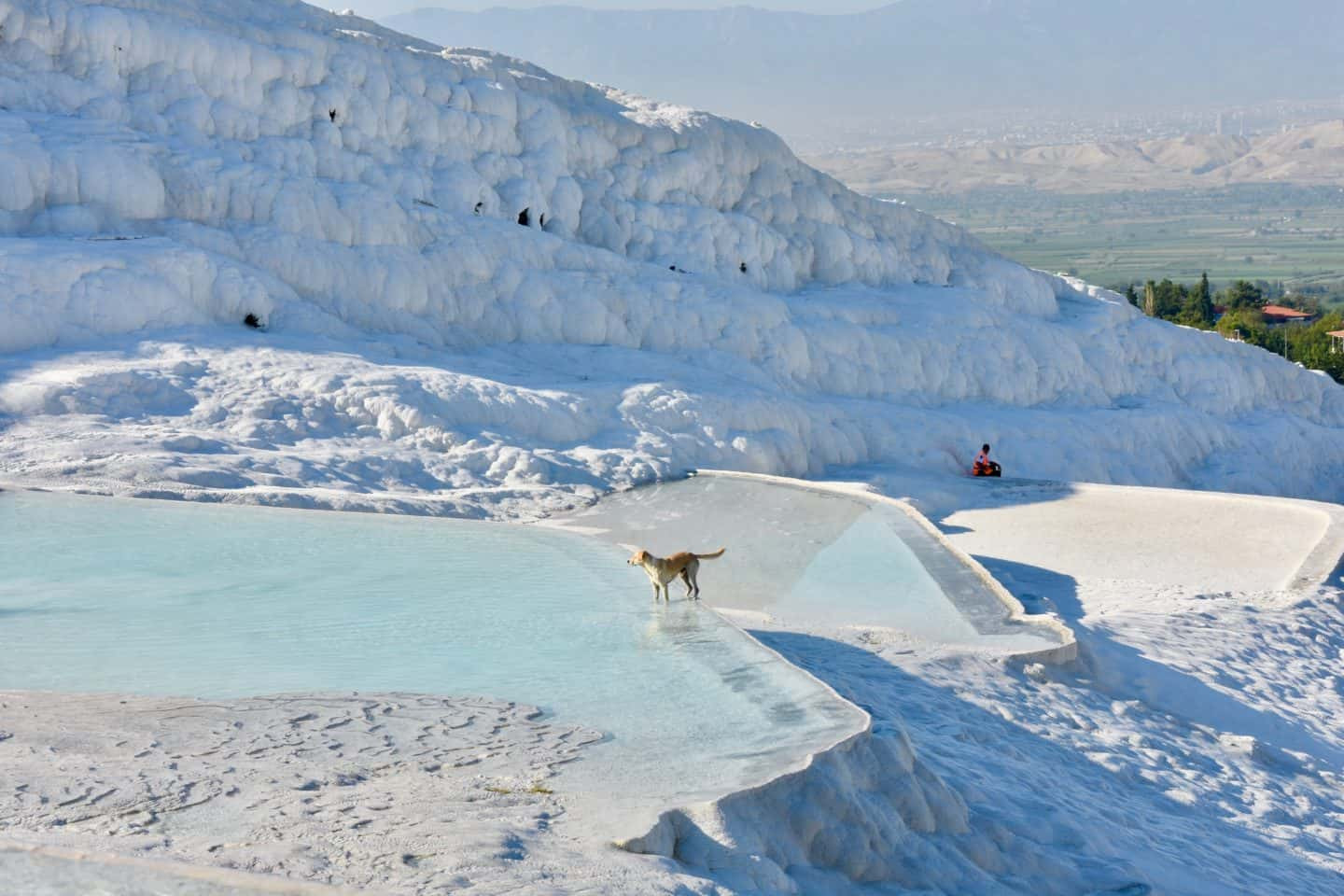 Pamukkale dog
Pamukkale dog
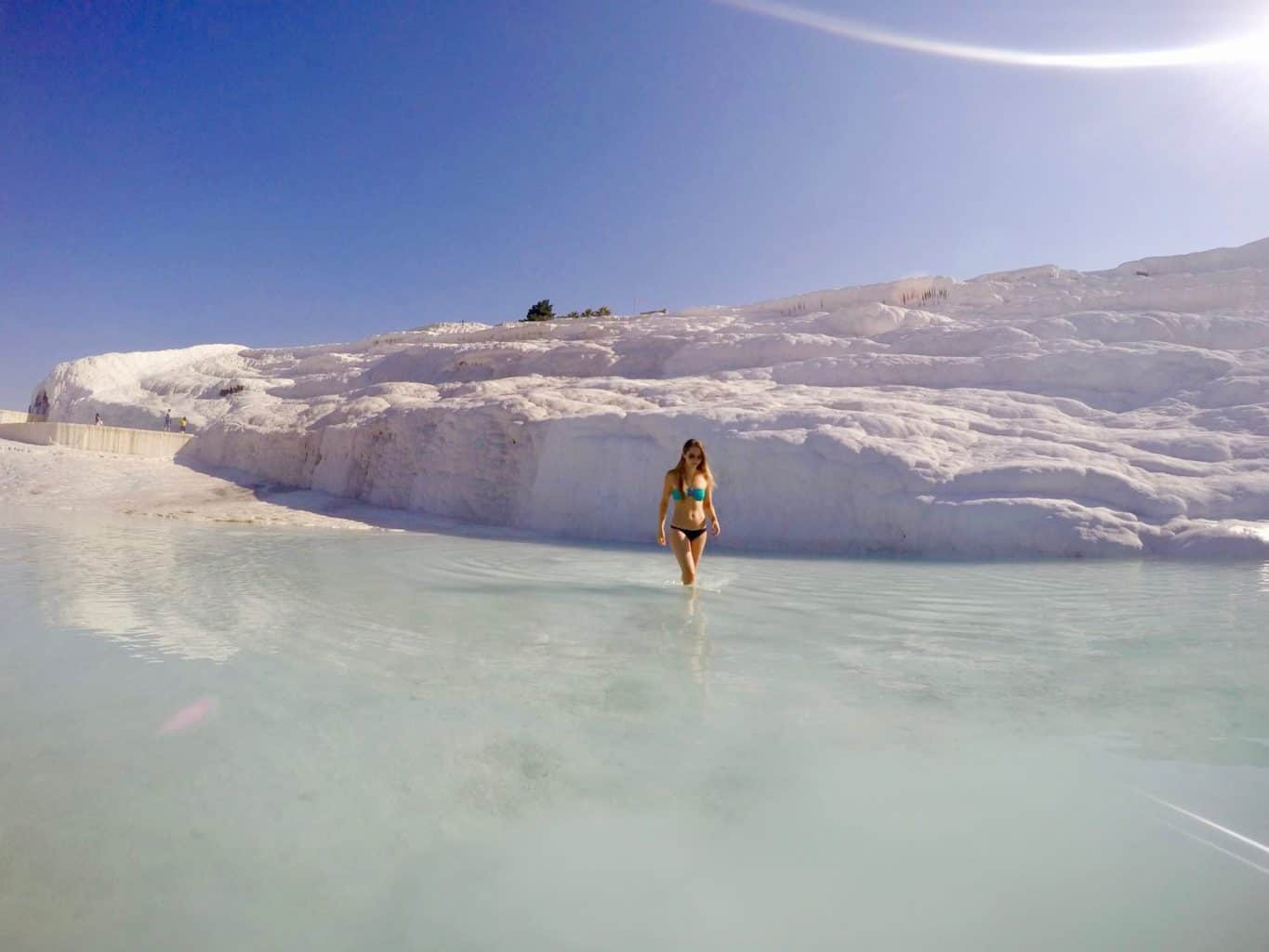 Pamukkale pools
Pamukkale pools
3.3.1. Pamukkale Accommodation: Where to Stay
If you choose to stay overnight in Pamukkale, there are several mid-range hotels to choose from. I stayed at the Melrose House Hotel, which was the perfect base from which to explore Pamukkale.
If you are looking for something a little more fancy, choose Doğa Thermal Health & Spa or Richmond Pamukkale Thermal.
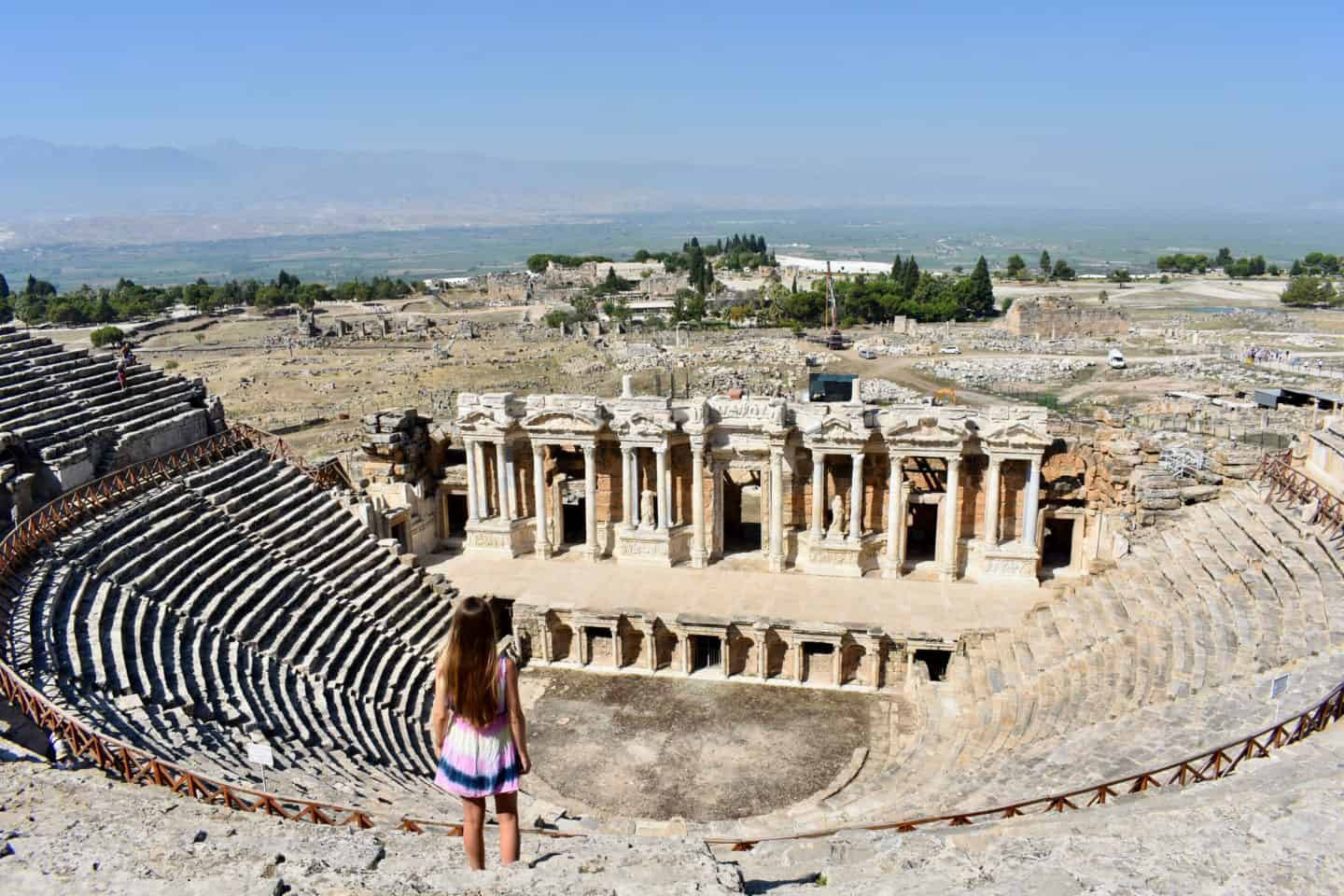 Hierapolis views
Hierapolis views
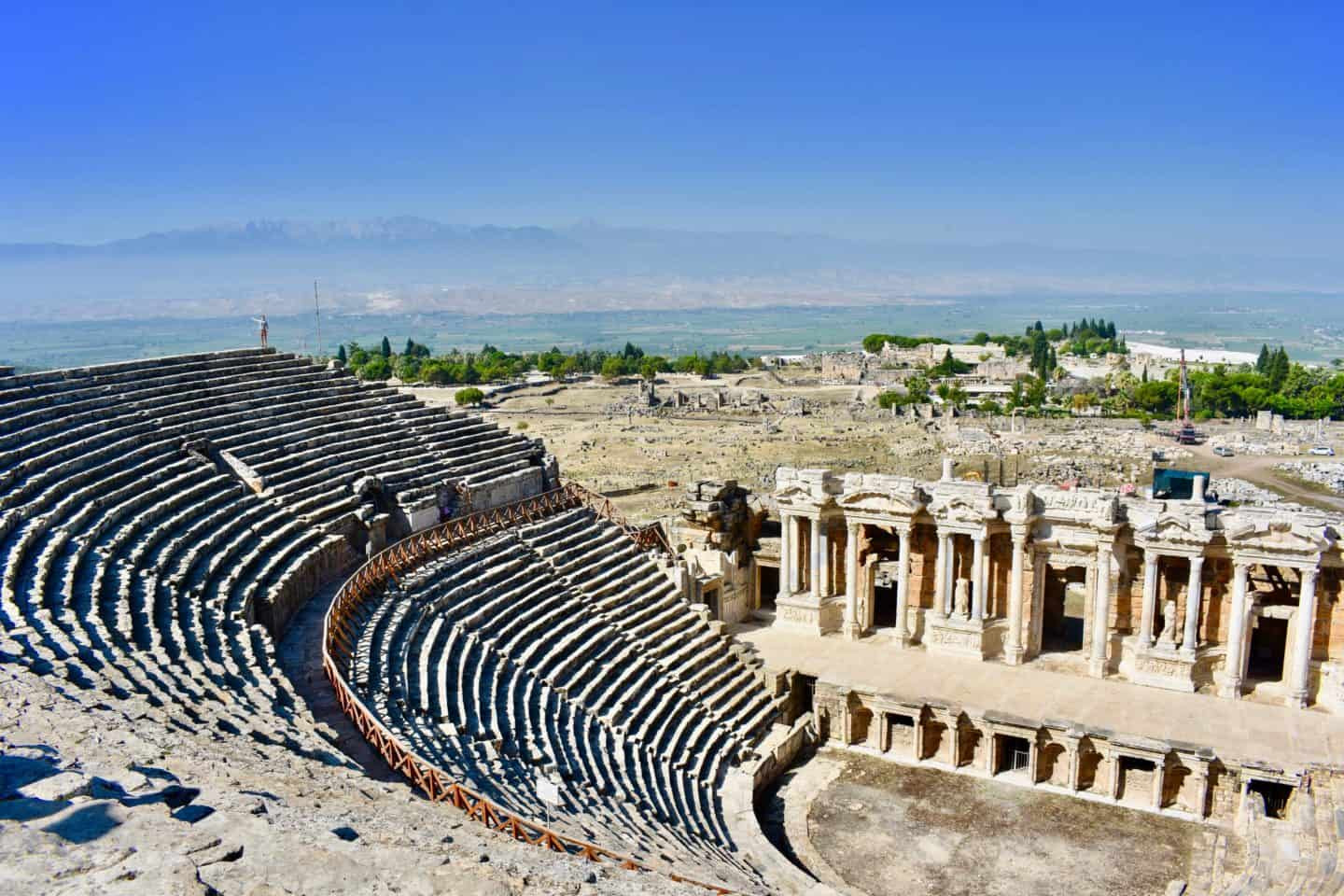 Hierapolis amphitheater
Hierapolis amphitheater
3.4. Turquoise Coast Sailing: A Must-Do Experience
Next stop: Fethiye for a gulet cruise. Travel time from Denizli to Fethiye: 2hr40 by direct bus
Sailing along the Turquoise coast is a magical way to spend time in this beautiful country. You will not regret including a gulet cruise in your Turkey itinerary. The stunning coastline is lined with deep emerald green pine forests, craggy rock faces, charming Turkish villages, and fascinating history. This is also where you can go paragliding above Ölüdeniz.
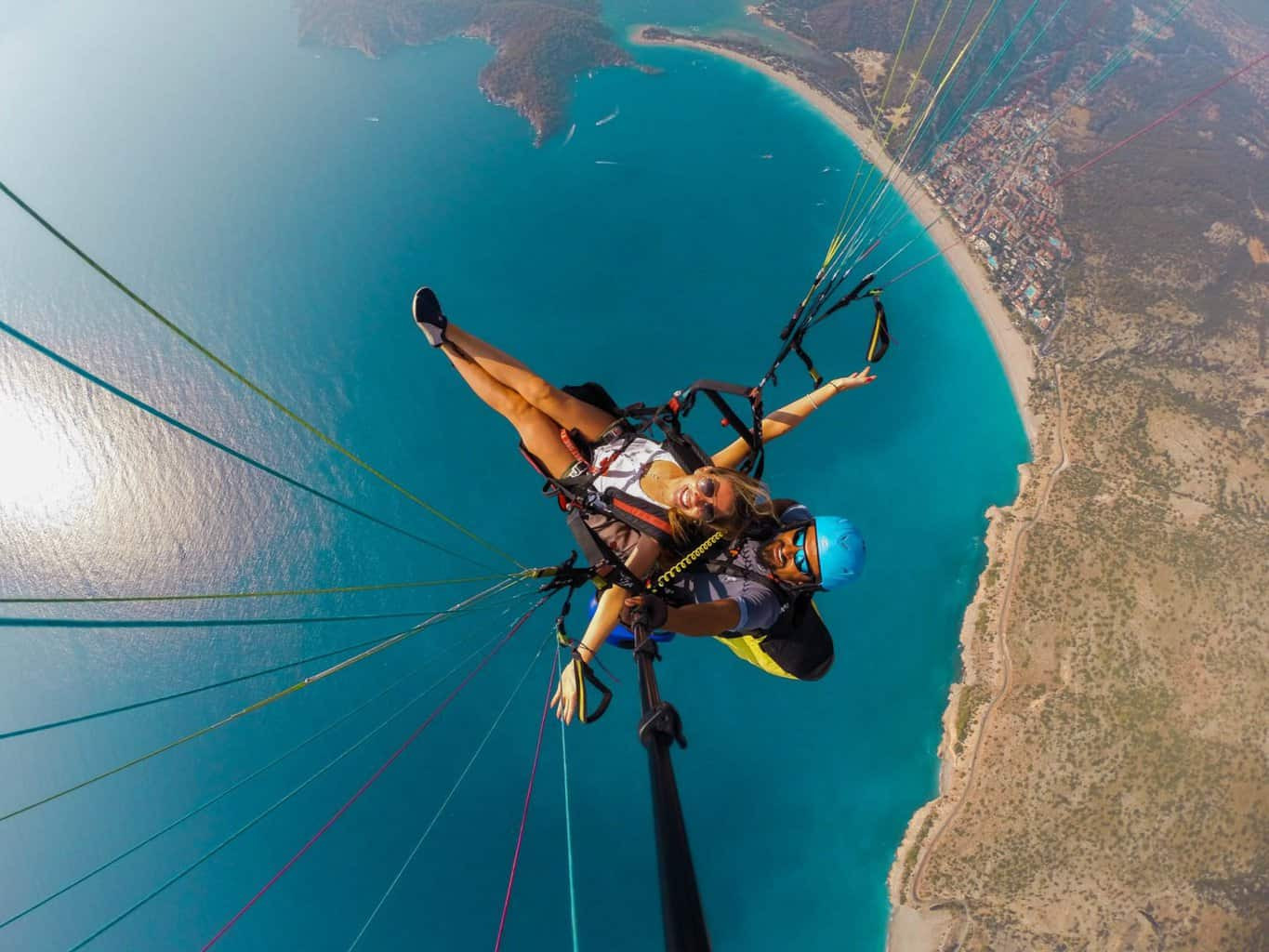 Paragliding in Ölüdeniz
Paragliding in Ölüdeniz
Spending a few nights on board a traditional Turkish wooden gulet cruise boat is a fantastic and authentic way to sail the coastline. The gulet boats tend to sail between Fethiye and Olympos, a town near Antalya. I departed from Fethiye for my gulet sailing trip.
I would not return to Fethiye for a longer trip because it was over-commercialized.
There are plenty of local companies to pick from for your sailing trip in Turkey. I recommend Alaturka Cruises. The gulet boat was great, the team fantastic, and their email support before the gulet departed was brilliant.
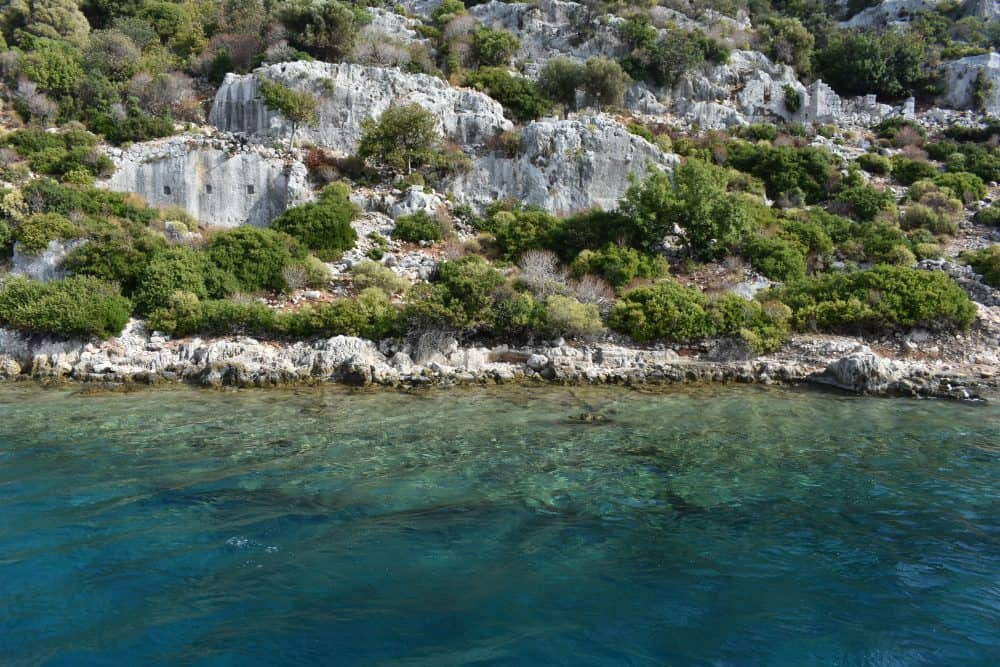 Kekova waters
Kekova waters
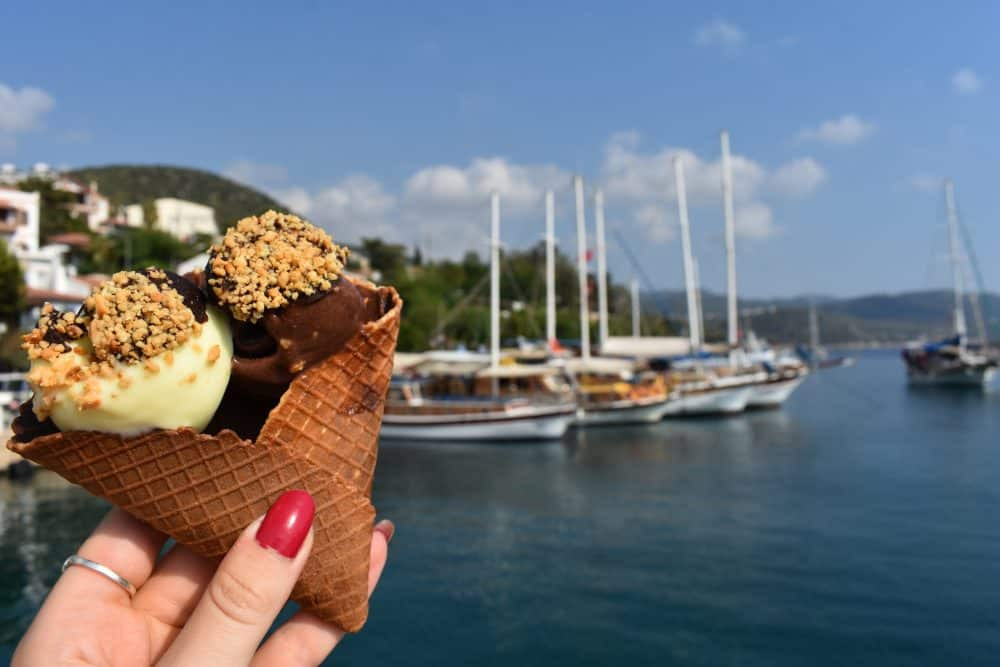 Traditional ice cream
Traditional ice cream
3.5. Istanbul: Bridging Continents
The sailing trips along the Turkish coastline tend to finish in Olympos. A unique town offers treehouse stays in a densely forested gorge. Instead of staying here, I took a domestic flight from Antalya to Istanbul.
Travel time from Olympos to Antalya airport on a bus: 1h30. Flight from Antalya to Istanbul: 1hr.
Istanbul is a city like no other. Straddling Asia and Europe, it is a melting pot of religions, cultures, backgrounds, and traditions.
An absolute must-visit destination in any 2-week Turkey itinerary, Istanbul offers a mesmerizing experience. From its Grand Bazaar, one of the biggest indoor markets in the world, to the Hagia Sofia, a religious structure used by Christians and Muslims.
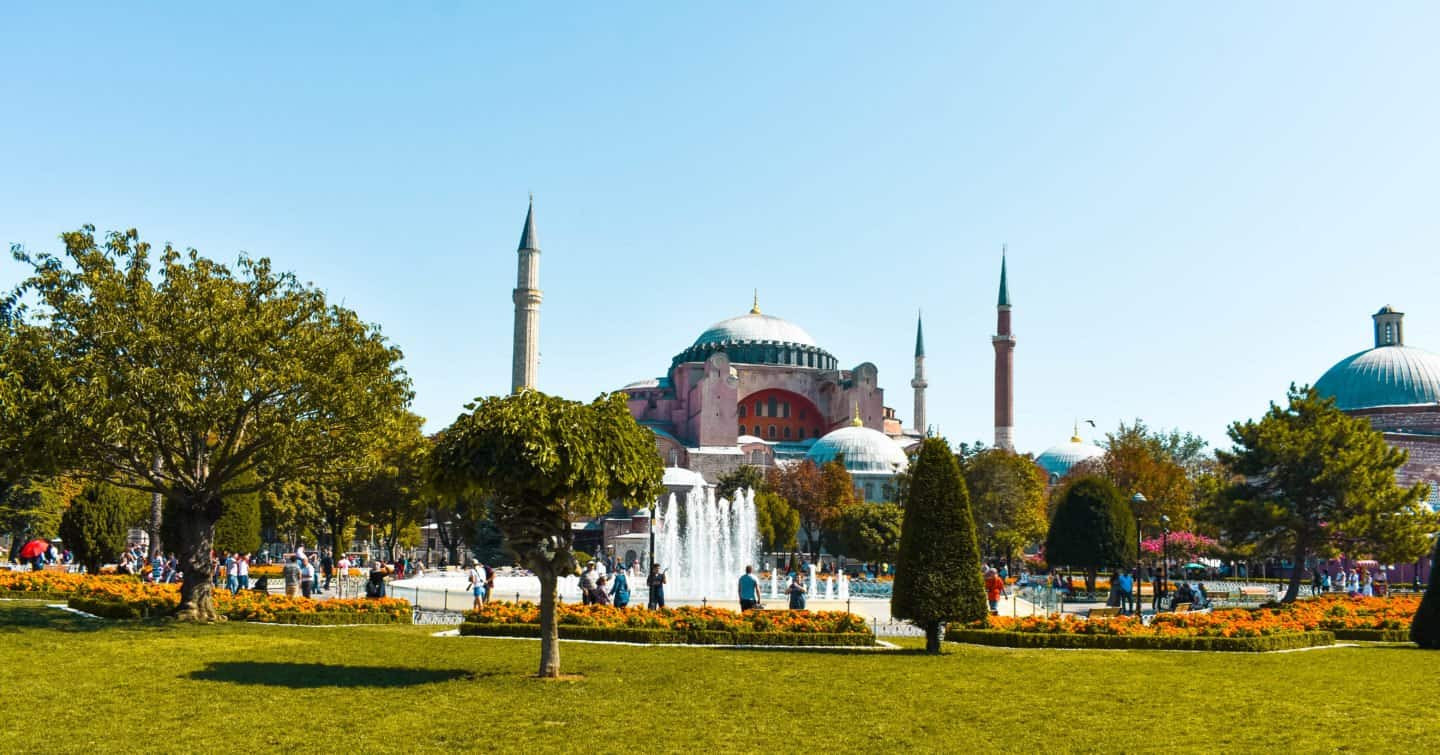 Istanbul gardens
Istanbul gardens
3.5.1. Istanbul Accommodation: Where to Stay
Istanbul has thousands of hotels to choose from, covering budget to ultra-luxurious stays.
I enjoyed an excellent stay at the Intercontinental Istanbul, which was well located and adjacent to Taksim Square. It offered an impressive breakfast and a lovely pool to enjoy after a long day of sightseeing.
Some of the other best luxury hotels in Istanbul include:
- Four Seasons Hotel Istanbul at Sultanahmet
- Çırağan Palace Kempinski Istanbul
- Swissôtel The Bosphorus Istanbul
If you are looking for somewhere as more of a comfortable base, these are some of the best value-for-money hotels in Istanbul:
- Hotel Amira Istanbul
- Sura Hagia Sophia Hotel
- The Ritz-Carlton, Istanbul
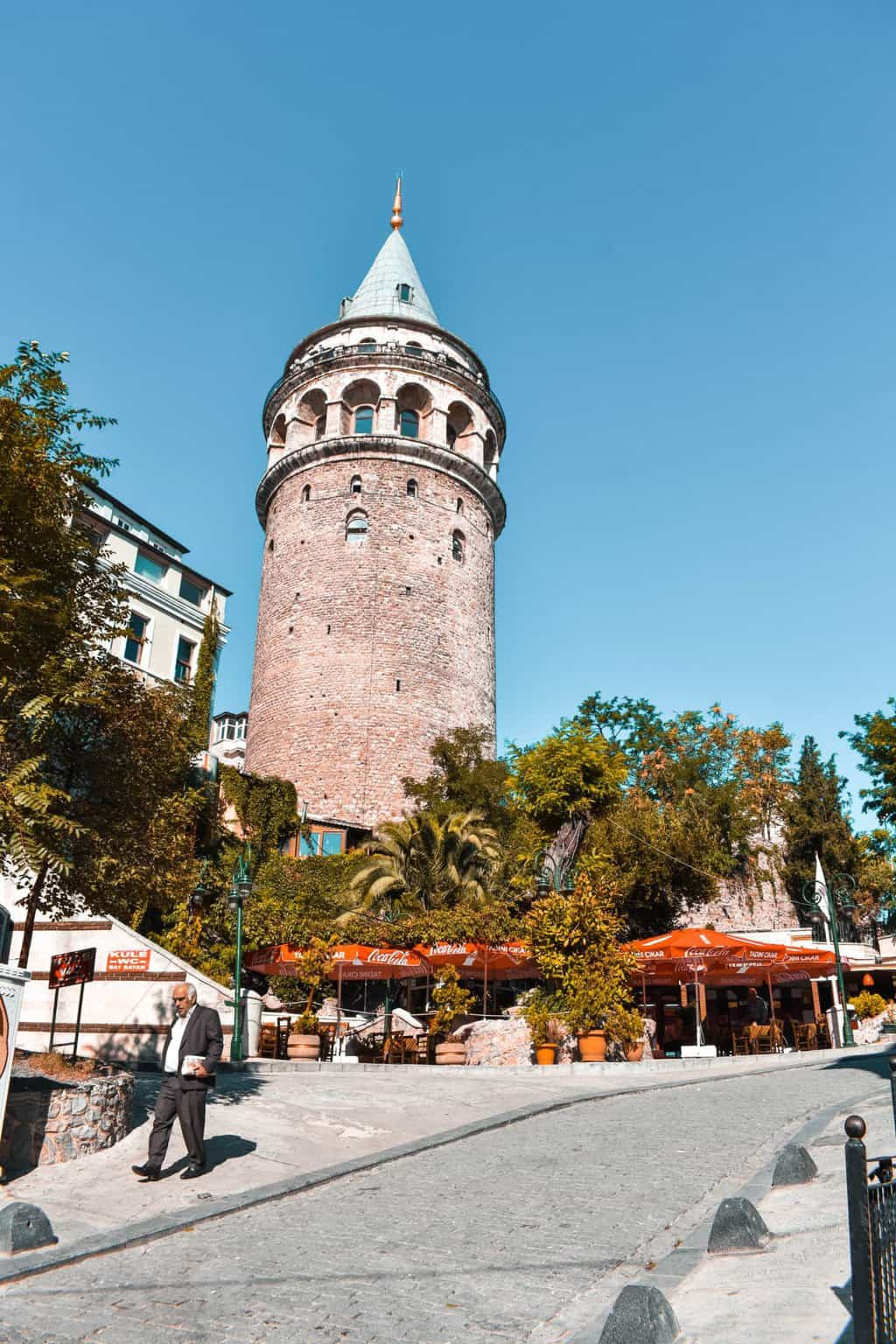 Galata Tower
Galata Tower
3.6. Cappadocia: Fairytale Landscapes
Travel time from Istanbul to Kayseri: 1hr flight
From Istanbul, it’s a quick and easy flight to Kayseri, the nearest airport to Cappadocia.
A visit to this surreal town with its magical fairy chimneys and mesmerizing sunrises is essential on any Turkey trip. Most of the best attractions and sites in Cappadocia can be visited in two or three days. Plus, with regular flights from several Turkey airports, it’s easy to include Cappadocia on any Turkey itinerary.
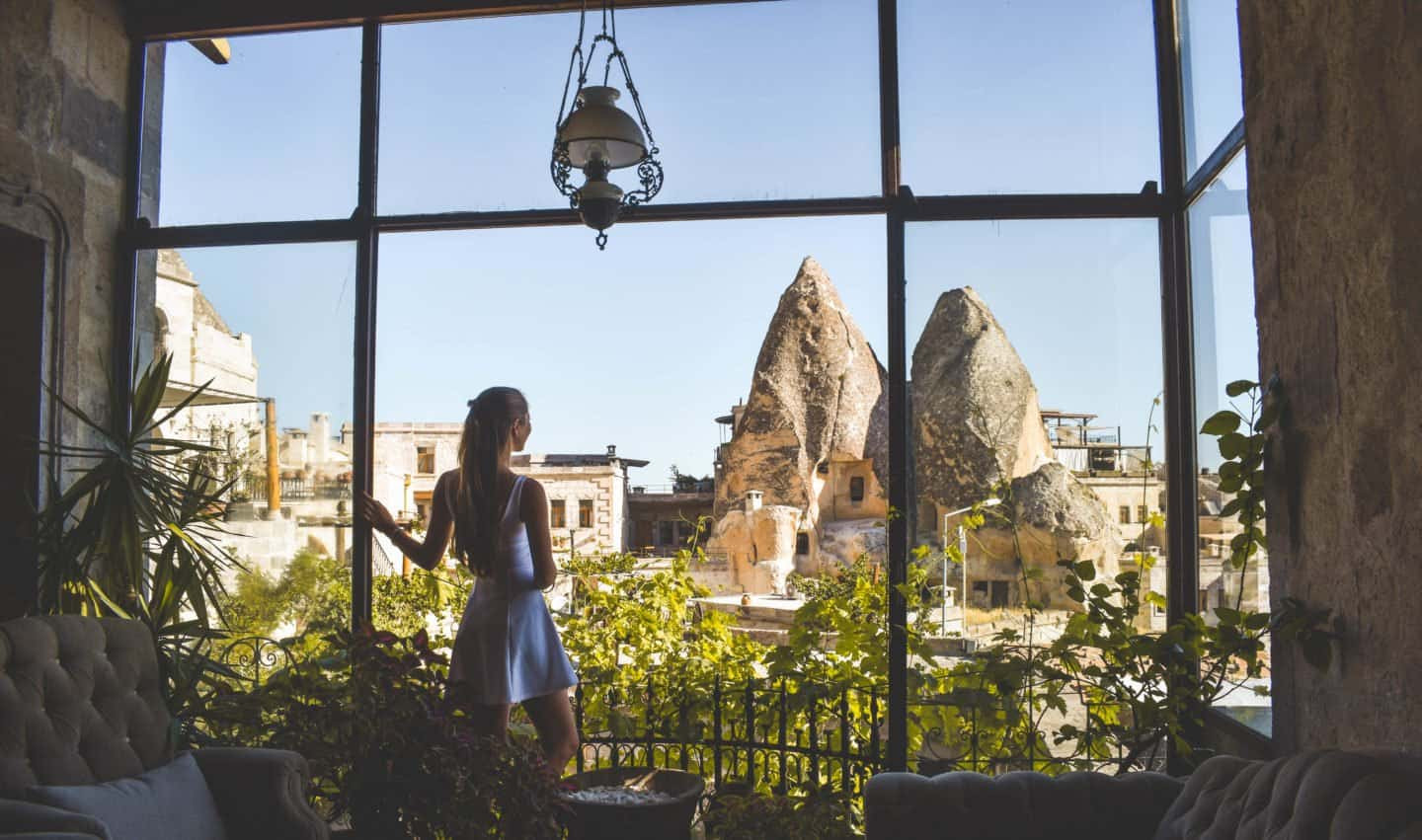 Sultan Cave Suites
Sultan Cave Suites
I spent four days in Cappadocia and thought it was one of the best places I have ever visited. Staying at a cave hotel is a must-do in Cappadocia. We stayed at the Sultan Cave Suites. This cave hotel has become famous because of its incredible terrace, the perfect place to capture a Cappadocia sunrise photo.
3.6.1. Cappadocia Cave Hotels: Unique Stays
There are so many cave hotels in Cappadocia, so it isn’t easy to decide where to stay.
Sultan Cave Suites is one of the most popular cave hotels to stay in Cappadocia.
However, if it is fully booked, there are still so many other amazing cave hotels.
Some of the other best cave hotels in Cappadocia include:
- Museum Hotel: Luxury and unique experience.
- Argos in Cappadocia: Amazing views and luxury.
- Kayakkapi Premium Caves: Offers luxury and excellent service.
 Sultan Cave Suites terrace
Sultan Cave Suites terrace
3.6.2. Cappadocia Attractions: What to See and Do
One of the best things to do in Cappadocia is witness one of the incredible sunrises. If you can, do it twice. Once from a viewpoint, such as the terrace at the Sultan Cave Suites hotel (you must be a guest), and once from a hot air balloon ride.
 Cappadocia sunrise
Cappadocia sunrise
But that’s not all there is to do in Cappadocia. Some of the other main attractions include visiting the Göreme Open Air Museum, exploring the nearby village of Uçhisar, and the rock formations at Pasabag and Devrent.
If you’re short on time, see all the top attractions in Cappadocia on an organized day tour. You can arrange this through your hotel, or book a tour through GetYourGuide.
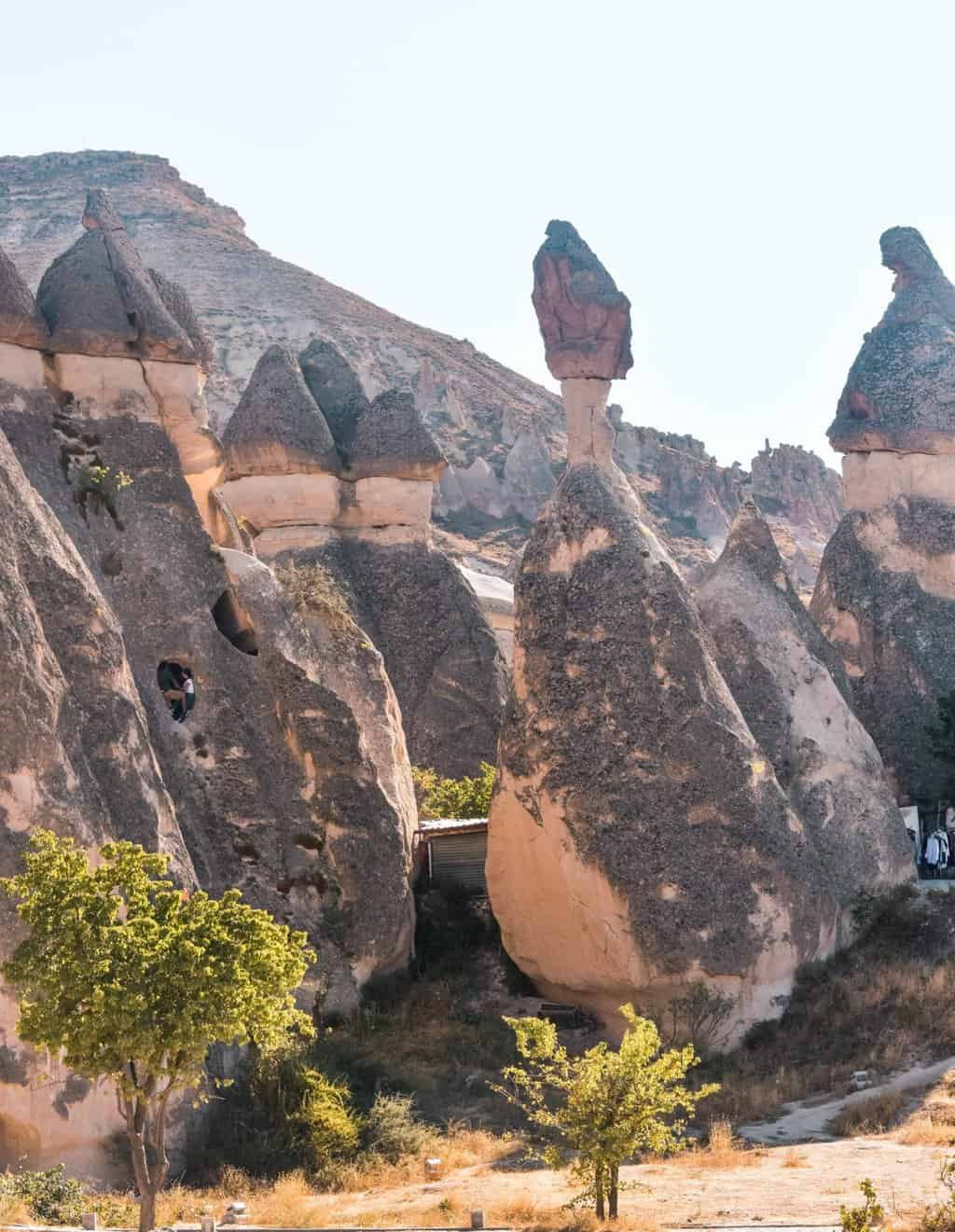 Cappadocia landscape
Cappadocia landscape
4. Your Perfect Turkey Itinerary Awaits
This 2-week Turkey itinerary combines historical sites, a sailing adventure, a cosmopolitan and cultural city, and the otherworldly magic of Cappadocia. I got around by public transportation, which I found safe, especially as a solo female traveler, as well as cost-efficient.
I hope this guide for a 2-week Turkey itinerary is useful. Naturally, the more time you have, the more places you can visit. Although some places, such as Pamukkale, you really don’t need to spend more than one day in.
Feel free to drop me a line if you would like any advice or further recommendations?
Ready to plan your dream Turkey vacation? Let SIXT.VN handle the details! Contact us today for personalized travel advice, seamless airport transfers, handpicked hotel options, unforgettable tours and activities, and flexible flight booking.
Address: 260 Cau Giay, Hanoi, Vietnam
Hotline/Whatsapp: +84 986 244 358
Website: SIXT.VN
FAQ: Your Turkey Travel Questions Answered
- What is the best time to visit Turkey for good weather?
The best time to visit Turkey for good weather is during the shoulder seasons, April-May and September-October. The weather is mild, and the crowds are smaller than in the peak summer months. - Do I need a visa to enter Turkey?
Visa requirements depend on your nationality. Check the official Turkish government e-visa website or contact the Turkish embassy in your country for the most up-to-date information. SIXT.VN can also assist you with this process. - What currency is used in Turkey?
The Turkish Lira (TL) is the official currency of Turkey. Credit cards are widely accepted in major cities, but it’s a good idea to carry some cash for smaller establishments and local markets. - Is it safe to drink tap water in Turkey?
It is generally not recommended to drink tap water in Turkey. Bottled water is readily available and affordable. - What should I wear when visiting mosques in Turkey?
When visiting mosques, dress modestly. Women should cover their heads, shoulders, and knees. Headscarves are often provided at the entrance. Men should also avoid wearing shorts. - What are some must-try Turkish foods?
Some must-try Turkish foods include: Kebab, Turkish delight, Baklava, Turkish coffee, and Pide (Turkish pizza). - How easy is it to get around Turkey using public transportation?
Turkey has an extensive and affordable public transportation system, including buses, trains, and domestic flights. It is easy to travel between cities and popular tourist destinations. - What is the best way to stay connected to the internet in Turkey?
You can purchase a local SIM card with a data plan upon arrival, or use Wi-Fi at hotels, cafes, and restaurants. - Are there any cultural customs I should be aware of in Turkey?
Yes, remove your shoes before entering someone’s home or a mosque. Bargaining is common in markets, but do so respectfully. Tipping is customary in restaurants and for services. - What are the best souvenirs to buy in Turkey?
Popular souvenirs include Turkish delight, Turkish coffee sets, carpets, ceramics, and spices.



